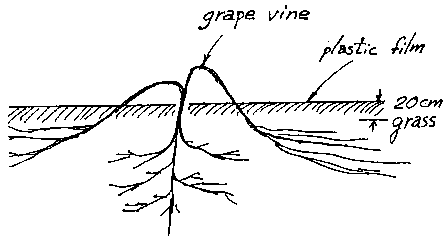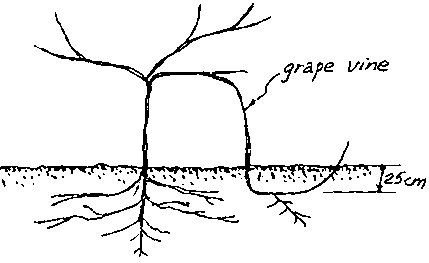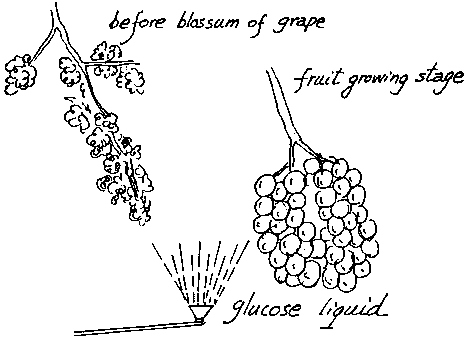Method of planting litchi
Mango tree care
Three key points to fruit tree grafting
Raising seedlings in paper bags
Pit preparation for fruit tree plantation by explosion
Three methods to prevent premature dropping of blossom and grapes
Grape orchard management for high yield
Method to produce seedless grapes
Digging the pit
Selecting the planting season
Selecting seedling varieties
Plant spacing
Pest control
Seedling care
A round-bottomed pit of 1-m depth and 1 m width should be first dug. The surface soil and other layers of soil should be disposed separately. The soil should be put back at the bottom of the pit, several days before planting. About 50 to 100 kg of grass, manure and rubbish, 1 to 1.5 kg of lime, 50 kg of organic fertilizer and 0.5 kg of phosphorus should be mixed with the rest of the soil and put back.
The season for planting litchi is based on the time of supply of the seedlings, the climate and also on the local custom. Generally, the best planting season is spring (February to April). The next best time for planting is summer (May to July). Planting can also be done in autumn (August to September).
Two varieties of litchis should be selected for plantation on large areas in order to help pollination and increase fruit setting ratio. The seedlings selected should be strong and of 50 to 60 cm heights, free from disease and pests.
For trees with large canopy, the spacing between the rows should be 6 to 7 m with about 250 trees/ha. For trees with small canopy, the spacing between rows should be 5 to 6 m with 330 trees/ha. About 8 cm thick soil should cover the roots of the seedling.
In order to prevent insect infestation, the BHC (bemzeme jexacjprode, a local pesticide) powder should be evenly scattered around the roots of the planted seedlings.
In order to keep the seedling stable, the soil around it should be pressed by hand and the seedling covered with grass straw after planting. Watering should be done slowly and regularly 5-6 times a month with light fertilizer application. A shady canopy of tree branches should be constructed around the seedling.
Fertilizer application
Tillage and weeding
Disease and insect control
As the flowering season approaches in February/March, the mango tree needs to be replenished with nutrients in order to have enough food for the baby fruit. To supplement the nutrients in the trees, organic and chemical fertilizers should be applied. For this a ditch 60 cm deep, 120 to 150 cm long and 40 to 60 cm wide should be dug around the tree canopy. 20 to 25 kg of organic fertilizer, 0.5 kg urea and potassium chloride should be added in the ditch and regular irrigation done during the spring to promote flower and baby fruit growth.
Tillage is generally done in spring along with the application of fertilizer. In orchards where there are a lot of weeds, weeding can be done by spraying 1% Caogan phosphorus solution (a local weedicide).
The mango tree is attacked by several diseases and insects. One of the most common disease is anthracnose which can be controlled by spraying 1:1:100 to 3:3:100 Bordeaux mixture or diluted (1000 times with water) 50% Jiajitoubujun (a local pesticide) to the new sprout. Powdery mildew is another common disease in the mango tree, which can be controlled by spraying lime sulfur with a concentration of 0.4 Baume degree. Another common disease is leaf spot, which is, controlled by picking the sick leaves and by spraying 1:1:100 Bordeaux mixture or diluted Beijunqing (a local pesticide) with 1500 times water. The insect evening moth is controlled by spraying diluted (80 to 100 times water) mixture of Didiwei, Dibeichong (local pesticides) and 50% ammonium phosphate. The tree should be sprayed 2 to 3 times after an interval of 7 to 10 days. Leaf cicada is controlled by spraying diluted (1500 times) Roger oxide or phosphorus, 1 to 2 times at the beginning stage of insect growth.
Rational grafting period
Grafting, storage and grafting wax
Grafting and binding
The phonological period of plants can be used as indicators for rational grating period, e.g.. the most suitable period for grafting is when the buds on the grafting branch begin to sprout.
Before grafting, the scion will be taken and cut into several sections of 15 cm length and with a bud on top of each section. Meanwhile, the wax should be melted and boiled in hot water and then the two cut sides of the scion should be painted with the wax liquid. The scion can be storage now for grafting anytime.
A 5 cm wide and 50 cm long plastic rope is used for general grafting by binding the.scion with the cut point of the parent tree. The scion can be exposed to outside.
9 Compiled by Mr. Xu Dafu of the Jr. of Soil and water Conservation, China.
First paper bags from waste paper are prepared. Then nutritious soil is prepare by mixing well powdered 10 kg of black vitriol, 50 kg of coal, 2 kg of salts with 15 kg of urea. This mixture is put for fermentation for a day. Then it is mixed into 1500 kg of soil for filling in the paper bags. For quick sprouting, the desired seeds are soaked in warm water (45°C) for 24 hours and then put into plastic bags. The paper bags thus planted are kept on the raised broad beds in a nursery at a rate of 9600 bags/m2. The begs are regularly watered. The method saves labor, seeds, and farmland thus cost effective.
10 Compiled by Ma Weimin, Rural Water Conservancy Div., Water Resource Department, Hebei Province.
In areas with exposed rock, artificial explosion can be used for pit preparation for planting high value trees Powder is used to explode a pit to a depth of 1 m and a diameter of 2-3 m. Then good top soil and organic matter are put into the pit into which a seedling is planted and watered. The nitrogen from the explosion powder remains in the pit after explosion thus increasing the nutrients for fruit tree growth. However due to relatively higher costs of explosives, this method of pit digging can only be used for high value trees e.g. fruit trees.
Following three local methods are used in north China to prevent blossom and premature grape drop:
1. The cuticular is cut at lower part of parent branches in a circle so that photosynthesis matter gathers on the part above the cut circle of the branch during blossom period.
2. Keeping a leaf above flower heads of parent branches, cut some of the new buds above the leaf. Do not cut too much or too little.
3. Thin flower head and cut end of tassel, one week before blossom. Thin more for stronger vine while thinning less gives weaker wines. Fruit production can be increase if new bud is cut and flowers are thinned at the same time.
Preventing grape vine from freezing in winter by plastic film cover
Method to stimulate advanced fruiting of the grape vine
Spray glucose liquid for good yield of grapes
Bind pruned grapevine collecting it from grape trellis and cover it with a 20 cm thick grass covers. It is watered twice and covered with plastic film during winter.

During summer season, select new branches of grape vine, which have grown longer than 1 m and thick parent branches. Put them down from trellis and cut the bud at the end of those branches. Then, bury them 25 cm deep into mud and keep the end of the branches out of the mud. After that apply regular water, spray fertilizer and pesticide. The branches grow roots in the same year. Plant these branches with their root in the next year. This way gives higher survival rate and fruit bearing is advanced by a year.

Better yield of grapes can be harvested if sprayed with glucose liquid (1:800 glucose/ water ratio) during blooming, fruiting and harvest stages. It gives still better results if the liquid is further mixed with phospho-dihydroxy-potassium at a rate of 3000 g/ha..

1. Make a mixture of 1 gm giberellin and 10 liters of water. Put the flower head into mixture for 10 minutes about 2 weeks before the blossom stage. Repeat the same process 12 days after the end of blossom stage.
2. Make a mixture of 100 ppm giberellin and 400 ppm streptomycin and repeat the process at the same period as mentioned above. The use of this mixture can render 90% of the grapes seedless.

However, no bordeaux mixture should be sprayed 5 days before and till 2 days after the above treatments. If it rains soon after the above procedures, they should be repeated.